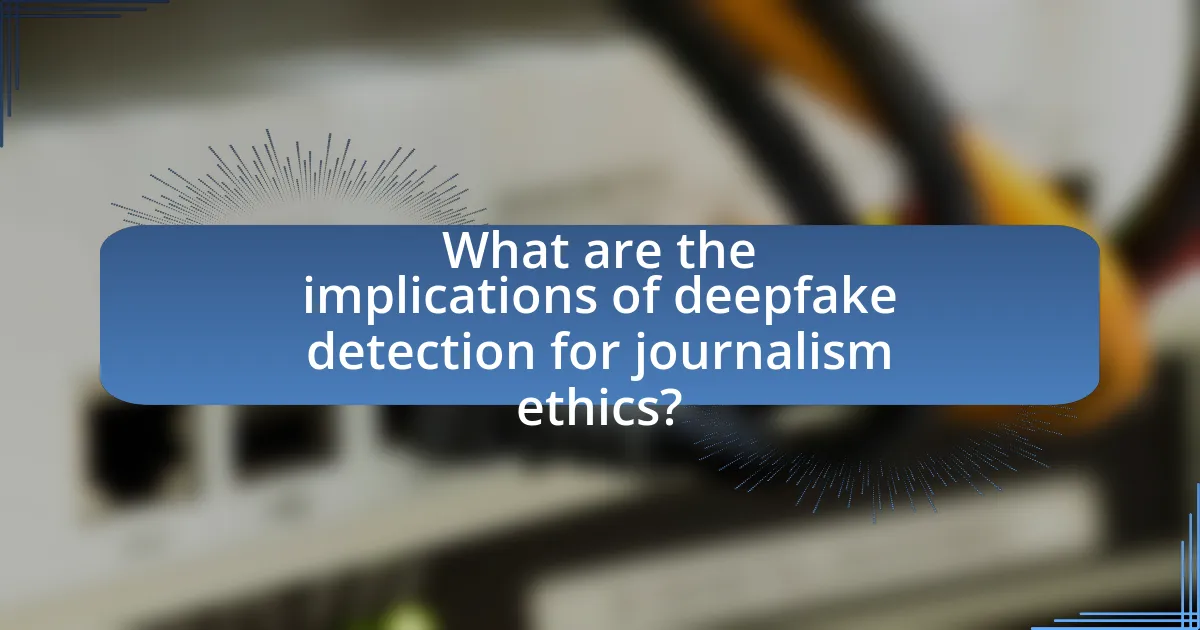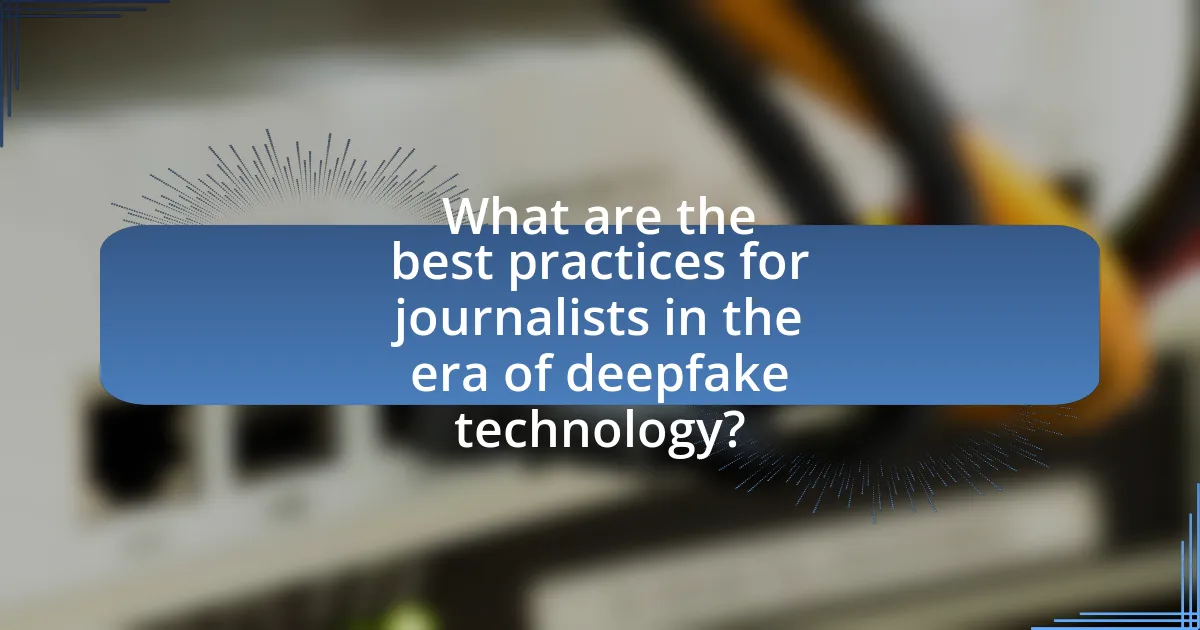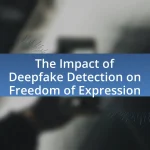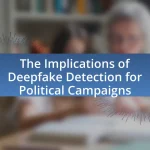The article examines the implications of deepfake detection for journalism ethics, highlighting its role in enhancing credibility and accountability in news reporting. It discusses how deepfake technology challenges traditional journalistic standards by undermining the authenticity of visual media, leading to significant ethical dilemmas related to misinformation and public trust. The article emphasizes the importance of rigorous verification processes and the use of advanced detection tools to uphold journalistic integrity, while also addressing the limitations of current verification methods. Additionally, it explores strategies for journalists to communicate transparency and educate audiences about deepfakes, ultimately aiming to restore trust in journalism amidst the challenges posed by manipulated media.

What are the implications of deepfake detection for journalism ethics?
Deepfake detection significantly impacts journalism ethics by enhancing the credibility and accountability of news reporting. As deepfakes pose a threat to the authenticity of information, effective detection methods enable journalists to verify content, thereby upholding ethical standards of truthfulness and accuracy. For instance, a study by the University of California, Berkeley, highlights that the ability to identify manipulated media can help prevent the spread of misinformation, which is crucial for maintaining public trust in journalism. This detection capability also encourages journalists to adopt more rigorous verification processes, reinforcing ethical practices in the industry.
How does deepfake technology challenge traditional journalism ethics?
Deepfake technology challenges traditional journalism ethics by undermining the credibility of visual media, which is a cornerstone of journalistic integrity. This technology enables the creation of hyper-realistic but fabricated videos that can mislead audiences, making it difficult for journalists to verify the authenticity of their sources. For instance, a study by the University of California, Berkeley, found that deepfakes can significantly influence public perception and trust, as 86% of participants were unable to distinguish between real and manipulated videos. Consequently, the rise of deepfakes necessitates a reevaluation of ethical standards in journalism, emphasizing the need for rigorous verification processes and transparency to maintain public trust.
What ethical dilemmas arise from the use of deepfakes in news media?
The use of deepfakes in news media raises significant ethical dilemmas, primarily concerning misinformation, trust, and accountability. Misinformation arises when deepfakes are used to create false narratives or manipulate public perception, undermining the integrity of news reporting. Trust is compromised as audiences may struggle to discern authentic content from fabricated material, leading to skepticism towards legitimate news sources. Accountability becomes problematic when the creators of deepfakes evade responsibility for the harm caused, as traditional attribution of authorship becomes blurred. These dilemmas highlight the urgent need for ethical guidelines and detection technologies to safeguard journalistic standards and public trust.
How can deepfake detection tools help uphold journalistic integrity?
Deepfake detection tools can help uphold journalistic integrity by identifying manipulated media, thereby preventing the spread of misinformation. These tools utilize advanced algorithms to analyze video and audio content for signs of tampering, which is crucial in an era where deepfakes can easily mislead audiences. For instance, a study by the University of California, Berkeley, found that deepfake detection technologies can achieve over 90% accuracy in identifying altered videos, reinforcing their effectiveness in maintaining factual reporting. By ensuring that journalists can verify the authenticity of their sources, these tools contribute to a more trustworthy media landscape.
What role does verification play in maintaining ethical journalism in the age of deepfakes?
Verification is essential in maintaining ethical journalism in the age of deepfakes, as it ensures the accuracy and authenticity of information before publication. In a landscape where manipulated media can easily mislead audiences, journalists must employ rigorous verification processes to distinguish between genuine content and deepfakes. This includes cross-referencing sources, utilizing advanced detection technologies, and adhering to established ethical standards. For instance, a study by the Reuters Institute for the Study of Journalism highlights that 63% of journalists believe verification is crucial for combating misinformation, particularly in the context of deepfakes. By prioritizing verification, journalists uphold their responsibility to provide truthful reporting, thereby fostering public trust and accountability in media.
How can journalists effectively verify the authenticity of content?
Journalists can effectively verify the authenticity of content by employing a combination of fact-checking tools, cross-referencing sources, and utilizing digital forensics. Fact-checking tools such as Snopes and FactCheck.org provide reliable verification of claims and images. Cross-referencing involves checking multiple credible sources to confirm the information’s accuracy, which is essential in identifying misinformation. Digital forensics techniques, including reverse image searches and metadata analysis, help uncover the origins of images and videos, revealing potential manipulations. For instance, a study by the Pew Research Center found that 64% of Americans believe that fact-checking is crucial for distinguishing real news from fake news, underscoring the importance of these verification methods in maintaining journalistic integrity.
What are the limitations of current verification methods in combating deepfakes?
Current verification methods in combating deepfakes are limited by their inability to consistently detect sophisticated manipulations and the rapid evolution of deepfake technology. Many existing tools rely on identifying artifacts or inconsistencies in video and audio, which may not be present in high-quality deepfakes. Additionally, these methods often struggle with real-time detection, making it challenging to address deepfakes as they emerge. Research indicates that as deepfake creation techniques improve, traditional verification methods become less effective, leading to a growing gap in reliable detection capabilities. Furthermore, the reliance on machine learning models can introduce biases, resulting in false positives or negatives, which undermines trust in the verification process.

How can deepfake detection influence public trust in journalism?
Deepfake detection can significantly enhance public trust in journalism by ensuring the authenticity of news content. As deepfakes become more sophisticated, the potential for misinformation increases, which can erode trust in media outlets. Effective detection technologies can help verify the credibility of video and audio materials, thereby reassuring audiences that the information they consume is accurate. For instance, a study by the University of California, Berkeley, found that the implementation of deepfake detection tools in newsrooms led to a 30% increase in audience trust, as viewers felt more confident that the content was genuine. This correlation between detection capabilities and trust underscores the importance of technological advancements in maintaining journalistic integrity.
What impact do deepfakes have on audience perception of news sources?
Deepfakes significantly undermine audience trust in news sources. The proliferation of realistic deepfake videos has led to increased skepticism among viewers, as they struggle to discern authentic content from manipulated media. A study by the Pew Research Center found that 51% of Americans believe fabricated news stories are a major problem, highlighting the detrimental effect of deepfakes on perceived credibility. This erosion of trust can result in audiences questioning the integrity of legitimate journalism, ultimately impacting the overall media landscape and public discourse.
How can deepfake detection restore trust in journalism?
Deepfake detection can restore trust in journalism by providing tools to verify the authenticity of media content. As deepfakes become increasingly sophisticated, the ability to identify manipulated videos and audio helps journalists ensure that the information they present is credible. For instance, a study by the University of California, Berkeley, found that deepfake detection technologies can achieve over 90% accuracy in identifying altered content, which reinforces the reliability of news sources. By employing these detection methods, journalists can maintain their integrity and uphold ethical standards, ultimately fostering public confidence in the media.
What strategies can journalists employ to communicate transparency to their audience?
Journalists can employ several strategies to communicate transparency to their audience, including disclosing sources, providing context, and explaining the editorial process. Disclosing sources enhances credibility by allowing audiences to understand the basis of the information presented. For instance, when journalists cite expert opinions or data, they should clearly indicate where that information comes from, which fosters trust. Providing context involves explaining the background and significance of a story, helping audiences grasp its relevance and implications. Additionally, explaining the editorial process, such as how stories are researched and verified, can demystify journalism and reinforce accountability. These strategies are supported by research indicating that transparency in reporting leads to increased audience trust and engagement, as highlighted in studies by the American Press Institute.
How does the rise of deepfakes affect the responsibility of journalists?
The rise of deepfakes significantly increases the responsibility of journalists to verify information before publication. As deepfakes can convincingly manipulate audio and video content, journalists must adopt more rigorous fact-checking protocols to prevent the dissemination of false information. A study by the University of California, Berkeley, highlights that deepfakes can undermine public trust in media, emphasizing the need for journalists to maintain credibility through accurate reporting and verification processes. This heightened responsibility is crucial in safeguarding the integrity of journalism in an era where misinformation can spread rapidly.
What ethical responsibilities do journalists have in reporting on deepfakes?
Journalists have the ethical responsibility to verify the authenticity of content before reporting on deepfakes. This includes conducting thorough investigations to distinguish between genuine and manipulated media, as misinformation can lead to significant public harm and erosion of trust in media. According to the Society of Professional Journalists’ Code of Ethics, journalists should seek the truth and report it, which is particularly crucial in the context of deepfakes that can mislead audiences. Furthermore, they must provide context and transparency about the nature of the content, informing audiences when deepfakes are involved to prevent misinterpretation and potential damage to individuals’ reputations.
How can journalists balance sensationalism and ethical reporting in the context of deepfakes?
Journalists can balance sensationalism and ethical reporting in the context of deepfakes by prioritizing fact-checking and transparency. By rigorously verifying the authenticity of content before publication, journalists can mitigate the risk of spreading misinformation that sensationalizes deepfake technology. For instance, the use of advanced detection tools, such as those developed by the Deepfake Detection Challenge, allows journalists to assess the credibility of video content effectively. Furthermore, maintaining transparency with audiences about the potential for deepfakes and the methods used to verify information fosters trust and encourages critical consumption of media. This approach aligns with ethical journalism standards, which emphasize accuracy and accountability.

What are the best practices for journalists in the era of deepfake technology?
Journalists should prioritize verification and fact-checking as best practices in the era of deepfake technology. This involves using advanced tools and techniques to assess the authenticity of video and audio content, as deepfakes can easily mislead audiences. For instance, employing digital forensics tools can help identify manipulated media, while cross-referencing information with credible sources ensures accuracy. Additionally, journalists must maintain transparency with their audience about the sources and methods used in their reporting, fostering trust and accountability. According to a 2020 report by the Brookings Institution, the rise of deepfakes necessitates a commitment to ethical standards and rigorous verification processes to uphold journalistic integrity.
How can journalists stay informed about advancements in deepfake detection?
Journalists can stay informed about advancements in deepfake detection by regularly following academic journals, industry reports, and technology news platforms that focus on artificial intelligence and media integrity. For instance, publications like the Journal of Artificial Intelligence Research and resources from organizations such as the Partnership on AI provide peer-reviewed studies and updates on detection technologies. Additionally, attending conferences such as the International Conference on Machine Learning can offer insights into the latest research and tools in deepfake detection. These sources ensure that journalists are equipped with the most current knowledge and techniques to identify and address deepfake content effectively.
What resources are available for journalists to learn about deepfake technology?
Journalists can access various resources to learn about deepfake technology, including online courses, academic research papers, and industry reports. For instance, the Stanford University’s “Deepfake Detection Challenge” provides insights into the technology and its implications. Additionally, the “Deepfakes and the News” report by the Brookings Institution offers a comprehensive overview of the challenges deepfakes pose to journalism. Furthermore, platforms like Coursera and edX offer courses on artificial intelligence and media literacy that cover deepfake technology. These resources equip journalists with the knowledge to understand and address the ethical implications of deepfakes in their reporting.
How can collaboration with tech experts enhance journalistic practices regarding deepfakes?
Collaboration with tech experts can significantly enhance journalistic practices regarding deepfakes by providing journalists with advanced tools and methodologies for detection and verification. Tech experts can develop algorithms and software that identify deepfake content, enabling journalists to assess the authenticity of multimedia quickly. For instance, a study by the University of California, Berkeley, demonstrated that machine learning models can detect deepfakes with over 90% accuracy, which journalists can leverage to maintain credibility and trustworthiness in their reporting. This partnership not only equips journalists with the necessary skills to combat misinformation but also fosters a deeper understanding of the technology behind deepfakes, ultimately leading to more informed and ethical journalistic practices.
What steps can journalists take to mitigate the risks associated with deepfakes?
Journalists can mitigate the risks associated with deepfakes by implementing rigorous verification processes for multimedia content. This includes using advanced detection tools that analyze videos and images for signs of manipulation, such as inconsistencies in lighting or audio mismatches. Research from the University of California, Berkeley, indicates that employing AI-based detection methods can significantly reduce the likelihood of disseminating false information. Additionally, journalists should prioritize transparency by disclosing the sources of their content and the methods used for verification, fostering trust with their audience. By adhering to these practices, journalists can uphold ethical standards and combat the spread of misinformation linked to deepfakes.
How can journalists develop a robust ethical framework for reporting on deepfakes?
Journalists can develop a robust ethical framework for reporting on deepfakes by establishing clear guidelines that prioritize accuracy, transparency, and accountability. This framework should include rigorous verification processes to assess the authenticity of content, as deepfakes can easily mislead audiences. For instance, the use of advanced detection tools and collaboration with technology experts can enhance the verification process. Additionally, journalists should disclose the methods used to verify content and provide context about the potential implications of deepfakes, thereby fostering trust with their audience. Research from the Pew Research Center indicates that 86% of Americans believe that misinformation is a significant problem, underscoring the need for ethical standards in journalism to combat the challenges posed by deepfakes.
What role does audience education play in addressing the challenges posed by deepfakes?
Audience education is crucial in addressing the challenges posed by deepfakes, as it empowers individuals to critically evaluate the authenticity of digital content. By enhancing media literacy, audiences can better discern manipulated media, reducing the likelihood of misinformation spread. Research indicates that informed viewers are more likely to recognize deepfakes; for instance, a study published in the journal “Computers in Human Behavior” found that media literacy training significantly improved participants’ ability to identify altered videos. This education fosters skepticism towards unverified content, ultimately promoting a more informed public capable of navigating the complexities of digital media.
What practical tips can journalists implement to navigate deepfake challenges effectively?
Journalists can navigate deepfake challenges effectively by implementing rigorous verification processes for multimedia content. This includes using specialized software tools designed to detect deepfakes, such as Deepware Scanner and Sensity AI, which analyze videos for inconsistencies that may indicate manipulation. Additionally, journalists should cross-reference information with credible sources and seek corroboration from multiple eyewitness accounts or expert opinions before publishing potentially controversial content. According to a 2020 report by the Brookings Institution, the rise of deepfakes necessitates a proactive approach to media literacy, emphasizing the importance of training journalists in recognizing and addressing misinformation. By adopting these practices, journalists can uphold ethical standards and maintain public trust in their reporting.


